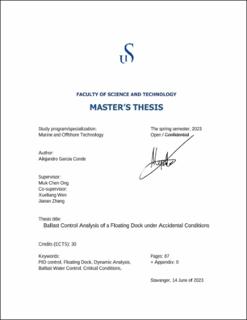| dc.description.abstract | Floating docks play a critical role in the maintenance and inspection of submerged sections of ships. However, their operational complexity requires the expertise of a skilled dock master to develop an optimal ballast plan that minimizes heeling and trimming during operations. Unfortunately, recent years have witnessed several accidents involving floating docks, often attributable to component failures or human errors. To address these risks and proactively detect potential dock failures, an automatic controller for floating docks has been developed. The proposed modified P-controller serves as a valuable tool for facilitating both ballasting and de-ballasting operations while effectively maintaining the dock's roll and pitch angles close to zero, even when a vessel is docked on deck. To evaluate the controller's effectiveness, it is tested under various conditions, including scenarios where certain components of the ballast water system are non-functional. During the de-ballasting process, the dock successfully completes the operation. However, the closure of at least two tanks within the same circuit results in significant pitch angles, indicating a limitation of the controller under these conditions. Similarly, in the ballasting process without a docked vessel, the controller performs satisfactorily. However, when a vessel is present, the dock fails to achieve the desired draught of 10.1 m. These observations provide valuable insights into the potential benefits and limitations of the proposed automatic controller for floating docks. These findings underscore the importance of further research and development in this field to enhance the performance and capabilities of automatic controllers for floating docks. By addressing the limitations identified and refining the controller's functionality, the safety and efficiency of floating dock operations can be significantly improved. | |
